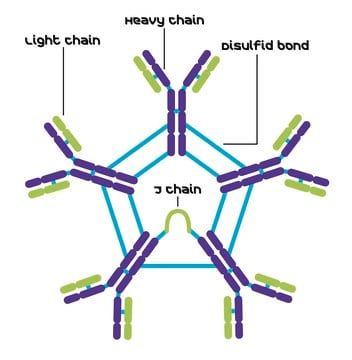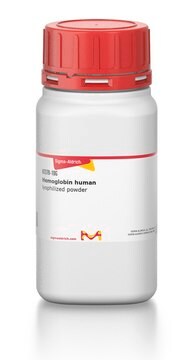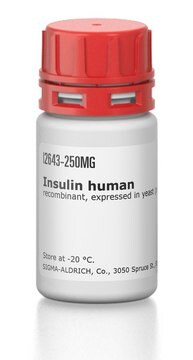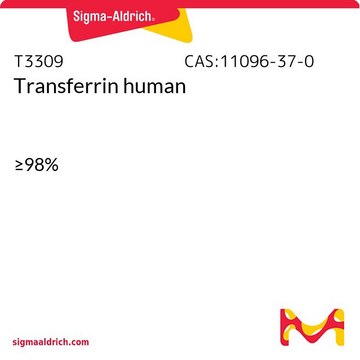Recommended Products
biological source
human liver
Quality Level
sterility
0.2 μm filtered
type
Type IV
Assay
≥95% (SDS-GE)
form
liquid
mol wt
H subunit ~21 kDa
L subunit ~19 kDa
~440 kDa (a shell of 24 protein subunits (apoferritin) and a core of Fe3+ ions)
packaging
vial of 2 μg
concentration
10 μg/mL
storage temp.
2-8°C
Gene Information
human ... FTH1(2495) , FTL(2512) , FTMT(94033)
General description
Ferritin comprises 24-subunit and belongs to the ferritin-like diiron-carboxylate protein superfamily. Ferritin exists as heavy (H) and light (L) subunits. Liver ferritin is majorly L subunit and the spleen has the H submit. The L subunit is mapped to human chromosome 9q13.33 and the H subunit 11q12.3.
Application
Ferritin from human liver has been used as model protein in size-exclusion high-performance liquid chromatography technique and for synthetic nanopore translocation studies. It has also been used to test its effect on the susceptibility of shrimp (Litopenaeus vannamei) to the white spot syndrome virus.
Biochem/physiol Actions
A ubiquitous iron storage protein that plays a key role in iron metabolism. It serves as an intracellular iron reserve (particularly in spleen, liver, intestinal mucosa, and bone marrow) and functions in iron detoxification. Studies have shown that ferritin iron incorporation is mediated by a ferroxidase activity associated with ferritin H subunits and a nucleation center associated with ferritin L subunits. Release of iron from ferritin has an essential role in iron-dependent lipid peroxidation and may contribute to free radical-induced cell damage in vivo. Therefore, by binding iron, ferritin may function as an antioxidant.
Ferritins are part of the host defense system and play a role in response to viral infection in animals. The abnormal levels of ferritin are correlated to many tumors associated with the prostate, breast and brain. High levels of ferritin are implicated in inflammation and macrophage activation syndrome (MAS). Mutations in the light subunit chain can lead to the neurodegenerative disease, hereditary ferritinopathy.
Physical form
Solution in 10 mM Tris, 150 mM NaCl, pH 8.0, and 0.1% sodium azide.
Storage Class Code
10 - Combustible liquids
WGK
WGK 1
Flash Point(F)
Not applicable
Flash Point(C)
Not applicable
Certificates of Analysis (COA)
Search for Certificates of Analysis (COA) by entering the products Lot/Batch Number. Lot and Batch Numbers can be found on a product’s label following the words ‘Lot’ or ‘Batch’.
Already Own This Product?
Find documentation for the products that you have recently purchased in the Document Library.
Customers Also Viewed
Yuan-Hwa Ruan et al.
Fish & shellfish immunology, 28(4), 542-548 (2010-01-05)
We examined the physiological (hemolymph glucose, lactate, and lipid) and innate non-specific immune responses (total hemocyte count (THC), phenoloxidase (PO) activity, respiratory bursts (release of superoxide anion, O(2)(-)) and superoxide dismutase (SOD) activity) to white spot syndrome virus (WSSV) in
P Ruscitti et al.
Clinical and experimental immunology, 191(2), 220-228 (2017-09-30)
Macrophage activation syndrome (MAS) is hyperinflammatory life-threatening syndrome, associated typically with high levels of serum ferritin. This is an iron storage protein including heavy (H) and light (L) subunits, categorized on their molecular weight. The H-/L subunits ratio may be
Ann Kruger et al.
Nephrology nursing journal : journal of the American Nephrology Nurses' Association, 40(2), 135-139 (2013-06-19)
This study examined whether a change infrequency of administration of erythropoietin-stimulating agent affected hemoglobin levels in patients on peritoneal dialysis. Data were extracted from the Australian Renal Anaemia Management database for the years 2002 and 2008. Less frequent dosing and
Rachel Collings et al.
The American journal of clinical nutrition, 98(1), 65-81 (2013-05-31)
Absorption factors are required to convert physiologic requirements for iron into Dietary Reference Values, but the absorption from single meals cannot be used to estimate dietary iron absorption. The objective was to conduct a systematic review of iron absorption from
Aurélie A Righetti et al.
The American journal of clinical nutrition, 97(6), 1364-1374 (2013-04-26)
Iron deficiency (ID) is a major cause of anemia, along with other nutritional, parasitic, and genetic factors. Accurate biomarkers are needed to estimate the relative contribution of ID to anemia. Soluble transferrin receptor (sTfR) is thought to be unaffected by
Our team of scientists has experience in all areas of research including Life Science, Material Science, Chemical Synthesis, Chromatography, Analytical and many others.
Contact Technical Service









